|
|
|
 |
None
of the lunar photos show stars in the sky. The moon doesn't have
an atmosphere so why can't we see the stars? |
This theory isn't quite as dumb as the evidence of the shadows, but it's a close call. Anyone seriously proposing it knows nothing about photography.
'Photographic expert' David S. Percy is sometimes quoted supporting this argument. How anyone can have the nerve to call themselves an 'expert' and yet put forward this idiotic theory is beyond me! It is practically impossible to capture a brightly and harshly lit object in the foreground (like, say, oh, an astronaut) and a dim object in the background (like a star) in the same exposure. Do a long exposure to capture the stars and you'll get a fuzzy overexposed blob in the foreground. Do a short exposure to capture the astronaut and the stars just won't appear. Guess what exposure the Apollo cameras used? The cameras they had with them were also small and mounted on the astronauts spacesuits. Any attempt at stellar photography would have needed long exposure times and result in very wobbly stars.
So why didn't they take any photos with long exposures and the camera on tripods? Probably because they weren't there to look at the stars. It is quite possible to take far better pictures of the stars with massive telescope cameras on Earth, even with an atmosphere, than with the tiny ones they took to the moon.
But don't take my word for this. Try it yourself. Go take a photo of a bright object, like a street light, against the night sky. You'll be very disappointed with the results.
As for the assertion that NASA couldn't fake the stars, had they wanted to. Well, this will come as a big shock to all the planetariums around the world.
The pictures of the Earth that were taken from the Moon are way too small. The Earth should be bigger.
This statement shows a
lack of understanding of camera focal lengths. Put simply, with a camera
of usual focal length (e.g. 45mm) you get tiny images of distant objects.
Try it yourself. Take a photo of the moon with your camera. You'll
get back from the developers a photo of a tiny white dot in the middle of a
black sky. The cameras used by the astronauts during the Apollo landings
were not really that much different to your camera in this respect.. They
weren't there to take photos of the Earth.
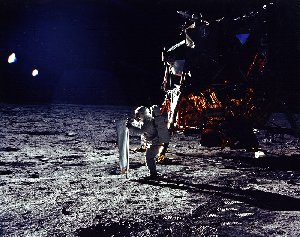
This photo, like others the
astronauts took, has strange blobs of light hanging in the moon's sky.
What are they then?
Another common item of 'proof' presented to prove...er... what exactly? Well, most hoax-geeks don't explain what these are meant to prove. They are so obvious that you'd think that if they proved the photos were fake then NASA would have air-brushed them out. And if they really are mysterious things in the moon's sky, then isn't that saying that the astronauts really were there? I suppose we shouldn't expect logic or consistency from hoax-geeks..
Either way, the blobs are no mystery at all and any photographer could identify them. They're caused by lens flare, effectively very bright light reflecting off the interior of the camera's lens. If you take a look at some of your own photos of a bright outdoors scene I bet you'll find similar ones.
Look, this photo shows girders and other objects in shot that couldn't have been on the Moon. It proves these photos were fakes taken on Earth.
Not quite. It
proves the photo was taken on Earth. A lot of the photos produced as
evidence are photos taken on Earth. What isn't said that these photos were
published prior to the moon landings and show astronauts in training.
No-one ever claimed they were from the moon.
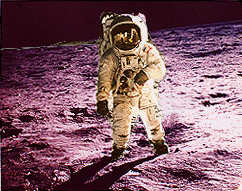 |
The famous 'man on the moon' photo taken by Armstrong of Aldrin is a view from above. You can tell this because you can see the top of Aldrin's head. But the camera was mounted on Armstrong's chest, below eye level. This proves that Armstrong did not take the photo as claimed and it is a fake. |
The 'proof' doesn't come any dumber than this. Armstrong was further up an incline on the moon's surface, so he was above Aldrin. Also Aldrin is leaning slightly forward. Due to the weight of the backback the astronauts had to do this to keep their balance. Again, a staggeringly simple explanation any backward five year old could grasp. But some people really don't get this.
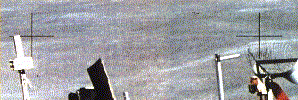 |
Here's a photo where the cross hairs on the camera actually go behind the moon buggy. How is this possible? It's not! So the photo must be faked! |
This could be confusing if you didn't understand how photography film works. All that's happened here is the over-exposed bright white object is catching the light and has "bled" into the thin black line. Not surprisingly you won't find the cross-hairs "disappearing behind" any other kind of object; it's always a bright white object where the film has been over-exposed.
This isn't unusual and a simple flaw you can replicate with yourself. Take a length of black thread and stretch it taut between your hands. Close one eye and hold it in front of the other eye so that you can just focus on it. Now hold it in front of a bright light bulb. Hey! The thread just appears to vanish where it crosses the brightest part of the light! Is it going behind the light? Or is your eye being 'over-exposed'?
What's ridiculous about this 'proof' of a hoax is what it's suppose to show. So the photo's faked? So how was it done? Was the moon buggy carefully stuck into an empty picture? Remember this is back in 1969 before digital image manipulation. It sounds like an awful lot of hard work when they could have just gone out to their faked landscape and just taken a proper photo!
Simon Pierce emailed me with a very good point about the cross-hairs that hadn't occurred to me before. If this 'anomaly' was the result of over-exposure then wouldn't we also see examples of it occurring to a lesser agree? Points where the white has bled into black cross-hair, but only slightly? Yes, we would. And helpfully Simon showed where we can find exactly that happening.
| This is
photograph AS12-48-7071 taken on the Apollo 12 mission. Several
parts of this photo are over exposed down the astronaut's left side
where the sun catches it.
If we zoom in on Astronaut Charles Conrad's visor we can see that the reflection of a bright object on the ground has bled into the cross-hair. It's neither behind or in front of the astronaut, so what was going on here when this photo was "faked"?? |
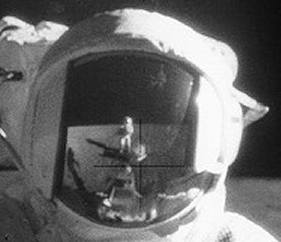 |
 |
The photos are just too good! Think about it, the supposed astronauts couldn't use a view finder and were wearing big gloves, yet they still managed to get the photos all in focus and framed perfectly! Obviously they got professional photographers in as part of the conspiracy. |
The Apollo 11 astronauts took hundreds of photos, something like 1400. Most of them were rotten and/or boring if rock formations don't exactly fascinate you. Out of focus, squint, blurred, accidentally taken, over exposed, under exposed. They're all there! Bizarrely NASA decided to pick the best ones to release and publicise. What were they thinking of?! The World demands out-of-focus snaps of Armstrong's thumb and a dim fuzzy picture of Aldrin's behind coming down the ladder!
The cameras themselves also had wide angled lens. This made it much easier for the astronauts to aim at whatever they wanted to capture. It could mean a lot of empty space around things though, but this could easily be trimmed off once the photo was developed.
The temperatures on the moon would have baked film until it frizzled. So the Apollo astronauts couldn't have taken any photos.
This theory is usually based on the fact that the moon's surface reaches about 280 degrees Fahrenheit during the long lunar day. (The moon has a day that lasts two weeks.) That's very, very hot. Fortunately, no-one went to the moon to spread film out on the moon's surface.
To begin with the lunar landings were timed so that they occurred during a lunar morning or evening, so no-one was out in the scorching heat taking photos at 'high noon'. This was done for the astronauts benefit rather than out of consideration for the camera film!
You also have to keep in mind that because there is no air, there is no ambient temperature and no convected heat on the moon. So if you are out of direct sunlight, and therefore radiated heat, you will be quite chilly. The film at all times would either be in the moon lander, or within a camera. Both had surfaces designed to reflect as much heat as possible rather than absorb it. So the film wouldn't even pick up much conducted heat from its container. So that's no convection, little radiation, little conduction. There are no other methods of receiving heat. I'd say there was actually more danger of the film freezing than baking.
| Who filmed Neil Armstrong coming out of the Lunar Module? There was no-one on the surface to do this! | 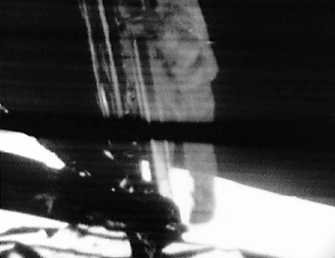 |
There was a video camera mounted and extended from the side of the landing module especially for this purpose. NASA correctly anticipated that the moment that Armstrong stepped onto the Moon would be thought as being particularly significant, and so made preparations to ensure it was captured 'on film'.
As Armstrong started down the ladder he remotely deployed it, swinging it out from its storage position in the side of the module. Note how the left hand side of the video image is obscured by both the side of the Lunar Module and the arm of the storage compartment that lowered it. (The horizontal black bar across the middle is interference flickering across the picture.) The way the camera was mounted meant that these first pictures were actually upside-down and had to be flipped over once received on Earth.
The same camera was then removed and used to send video pictures of the rest of the lunar activities from a stand on the lunar surface.